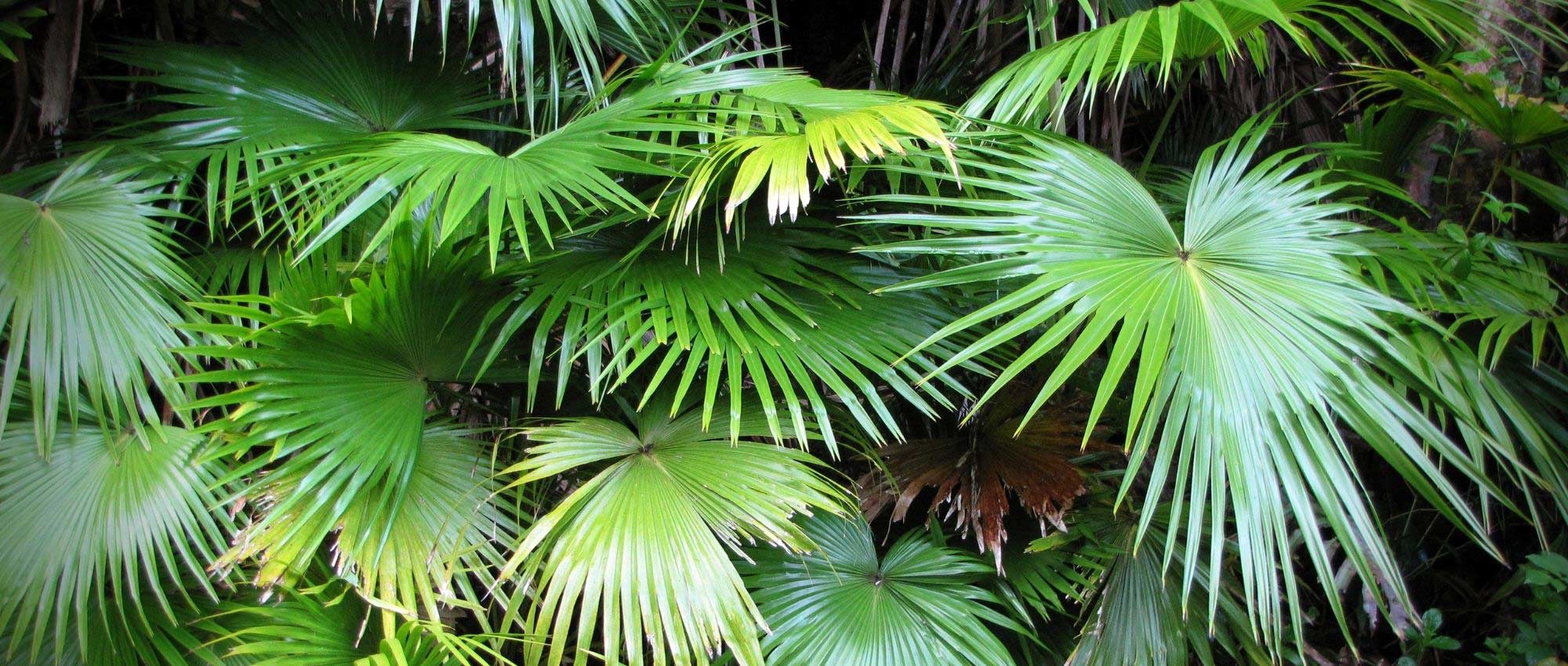
Livistona: planting, cultivation, and care
Contents
Livistona in a nutshell
- The Livistona is a majestic palm that bears large fan-shaped leaves
- It is mainly known as a houseplant, but some species can be grown in the garden
- To thrive, it needs warmth and humidity
- It is perfect for creating a very exotic atmosphere!
- This palm is still quite uncommon in gardens
- It adapts well to pot cultivation
- It is ideal for seaside gardens and easily finds its place near a pool, creating a tropical vibe!
A word from our Expert
The Livistona is a stunning palm that features large, glossy green leaves, fan-shaped, almost circular. The tips of its leaves tend to gracefully droop towards the ground, earning it the nickname “fountain palm.” There are about thirty species, native to the warm and humid regions of Southeast Asia and Australia. The most well-known is Livistona rotundifolia, cultivated as a houseplant. However, there are also species that adapt to outdoor cultivation: for example, Livistona chinensis, Livistona mariae and Livistona saribus, which can withstand temperatures between -6 and -8 °C. In regions with a very mild climate (such as the Mediterranean basin or the Breton coast), it is possible to grow them in the ground; however, in cooler areas, they will need protection in winter, for example by growing them in pots and bringing them indoors in autumn.
If you cultivate it in the garden, plant the Livistona in cool, fertile, and well-draining soil. We recommend pairing it with other plants that have lush foliage, such as Tetrapanax, Fatsia, ferns, Colocasia, or Japanese bananas. The Livistona will be perfect for creating a beautiful exotic scene by the sea or near a pool. You can also grow it in a large pot, which you can place on the terrace in spring and bring indoors in autumn. Ideally, it should be situated in a greenhouse or conservatory to benefit from excellent light.
Botany
Botanical data
- Latin name Livistona sp.
- Family Arecaceae
- Common name fan palm, fountain palm, Chinese Latanier
- Flowering summer, very rare indoors
- Height up to 20 m
- Exposure sun or partial shade
- Soil type cool, draining, fertile
- Hardiness variable, down to -8 °C for the hardiest
The Livistona are palms native to the humid forests of Southeast Asia and Australia. They prefer cool or moist soils and are often found in nature along waterways, near mangroves or marshes, and sometimes in ravines.
The Livistona was named in honour of Patrick Murray (1632-1671), a Scottish botanist and Baron of Livingston, who founded the Royal Botanic Garden Edinburgh in the 17th century. Sometimes, this palm is spelled Livistonia or Livingstonia. In English, the Livistona is also known as Latanier, fan palm, or fountain palm.
The Livistona comprises 28 species of palms. The most commonly cultivated is probably Livistona rotundifolia, grown as a houseplant due to its sensitivity to cold. It should be kept away from temperatures below 10 °C. Outdoors, in a mild climate, one would rather cultivate Livistona chinensis, L. mariae or L. saribus, which can withstand temperatures between -6 and -8 °C. In any case, the Livistona is a palm well-suited to regions with a mild climate, where the risk of frost is low, such as the Mediterranean basin or the Breton coast. Elsewhere, it is best grown in a pot so it can be brought indoors during winter.
Like other palms, the Livistona belongs to the large family of Arecaceae, which includes over 2,500 species. Contrary to popular belief, palms are neither trees nor bushes: they do not form wood or branches, and they do not have a “trunk” but a “stipe,” made up of stacked bases of petioles. Botanically, it would be more accurate to consider them as giant herbs.
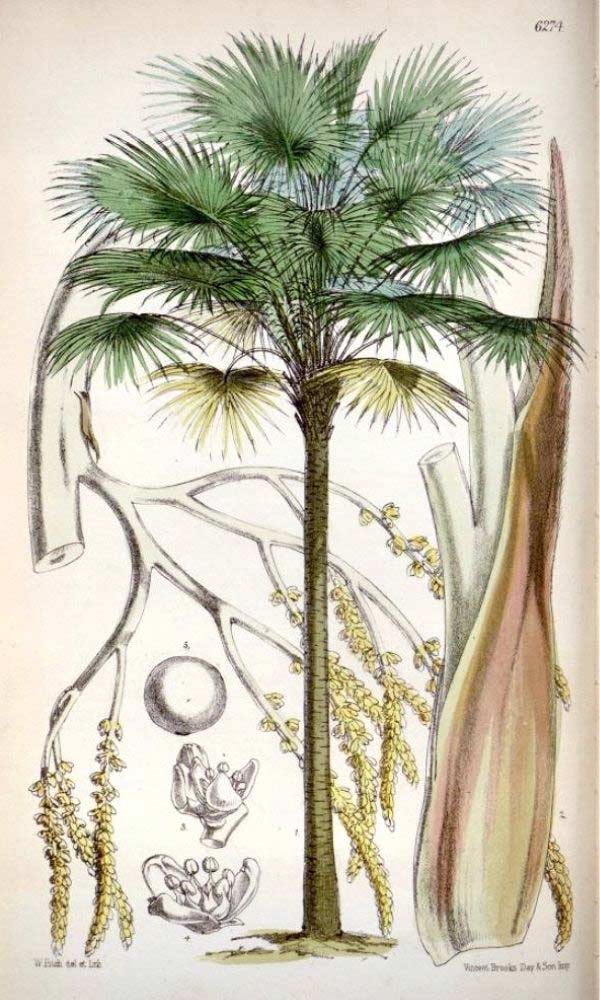
Livistona australis: Botanical illustration
The Livistona grows quite slowly, at least when cultivated in our climate. In its natural environment, under warm and humid conditions, it grows much faster! Like almost all palms, it has a single stipe, with only one apical meristem, and therefore cannot branch. The Livistona only grows in height! Thus, if the top of the stipe is cut off, the palm is doomed.
In the wild, Livistona can grow very tall: most species reach heights of 20 to 25 m, while Livistona saribus can reach up to 40 m! When cultivated in our climates, Livistona tends to be much smaller. When grown in pots, they rarely exceed 2 m in height!
At the top of the stipe, the Livistona bears a crown (crown) of large fan-shaped leaves, majestic in appearance. These leaves are referred to as “palmate,” in contrast to pinnate leaves (feather-shaped). The fronds are nearly circular, which gives the name to Livistona rotundifolia (= round-leaved). They are thick, leathery, and have a plicate, glossy lamina. The leaves of the Livistona typically measure between 80 cm and 1.5 m in diameter. Those of Livistona saribus can even reach up to 2 meters long and are deeply divided.
The leaves are borne on very long petioles, with edges covered in brown, hooked thorns. The fronds divide into many segments, which are fused at part of the lamina and then split further. On mature or older plants, they droop at the tips, cascading down, giving the palm a very distinctive appearance that is easily recognisable. This gives Livistona chinensis its nickname of fountain palm. The leaf segments of Livistona are generally bifid, divided into two at the tips.
Depending on the species, the fronds can be bright green or dark green, sometimes grey or slightly bluish. Young plants of Livistona mariae have the unique characteristic of bearing fronds of bronze-red colour (a rather rare trait for a palm!). The Livistona fulva, on the other hand, has a bronze-orange fuzz on the underside of its leaves!

The foliage of Livistona australis (photo John Tann), Livistona saribus (photo Daniel Rengel), and the spiny petiole of Livistona rotundifolia (photo Dariusz Kowalczyk)
The Livistona flowers in summer, typically in July-August. The flowers are grouped in branched panicles, inserted between the leaves. The inflorescences are short and dense, bearing a large number of small flowers. These are light yellow to cream in colour and consist of three petals. However, when the Livistona is grown as a houseplant, it is very rare for it to flower.
After flowering, the Livistona produces oval fruits, bluish-black or purplish, about 2 cm long. They resemble olives and are borne on the panicles, replacing the flowers.

The flowering and fruits of Livistona chinensis (photos EvaK / David J. Stang)
The main varieties of Livistona
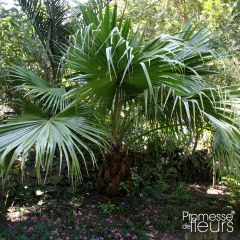
Livistona chinensis - Chinese Fan Palm
- Flowering time August, September
- Height at maturity 15 m

Livistona mariae - Central Australian fan Palm
- Flowering time August, September
- Height at maturity 20 m
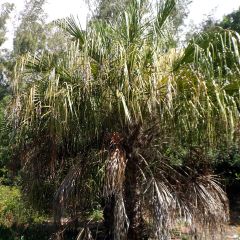
Livistona benthamii - Bentham's Fan Palm
- Flowering time August, September
- Height at maturity 18 m
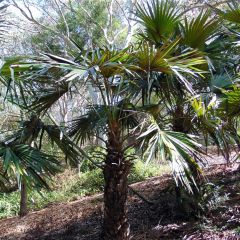
Livistona fulva - Chinese Fan Palm
- Flowering time August, September
- Height at maturity 13 m
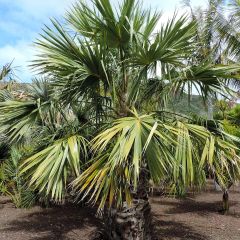
Livistona saribus - Taraw Palm
- Flowering time August, September
- Height at maturity 25 m
Discover other Livistona
View all →Available in 1 sizes
Available in 1 sizes
Available in 1 sizes

Available in 1 sizes
Available in 1 sizes
Planting
Where to plant?
Plant the Livistona in full sun or partial shade. It requires good light. Choose a spot sheltered from cold winds. As these are large palms with thorny petioles, ensure there is enough space and avoid planting them near high-traffic areas. For optimal growth, Livistona needs warmth and water!
Most Livistona prefer cool to moist soils, as they naturally grow along riverbanks. However, it is important that the soil is well-draining. They also appreciate fertile, light, deep, and loose soil.
The Livistona is particularly suited to regions with a mild climate, where the risk of frost is low. It is ideal, for example, for a seaside garden, where it will help create a beautiful exotic atmosphere.
If you live in a cooler region, plant it in a pot. You can take it out onto the terrace from spring to autumn, then bring it indoors in winter to protect it from the cold.
If you are cultivating, for example, Livistona rotundifolia, which is not hardy, keep it indoors all year round in a bright spot without direct sunlight. Ideally, it should be placed in a greenhouse or conservatory to benefit from excellent light. In winter, be careful to keep it away from radiators.
When to plant?
We recommend planting the Livistona in spring, around April, and outside of frost periods.
How to plant?
For planting in the ground:
- Dig a planting hole about three times the size of the root ball. Work the soil to loosen it and facilitate root establishment.
- Mix garden soil with potting compost and gravel or coarse sand (for drainage), then replace this mixture at the bottom of the planting hole.
- Gently remove the Livistona from its pot and plant it.
- Place it in the planting hole, then fill the hole with potting compost. Be careful not to bury the palm too deeply: the soil should be at the same level as it was in the pot.
- Firm it down with the palm of your hand, then water generously.
Continue to water regularly, at least during the first year.
For planting in a pot:
- Choose a large pot or container.
- Install a drainage layer at the bottom of the pot, made of clay balls or gravel.
- Place potting compost in the pot.
- Plant your Livistona, then add potting compost around it.
- Water generously.
- Place it indoors if it is a tender species (like Livistona rotundifolia), or outdoors on the terrace if you live in a region with low frost risk. Indoors, choose a bright spot without direct sunlight.
- Remember to water regularly afterwards.
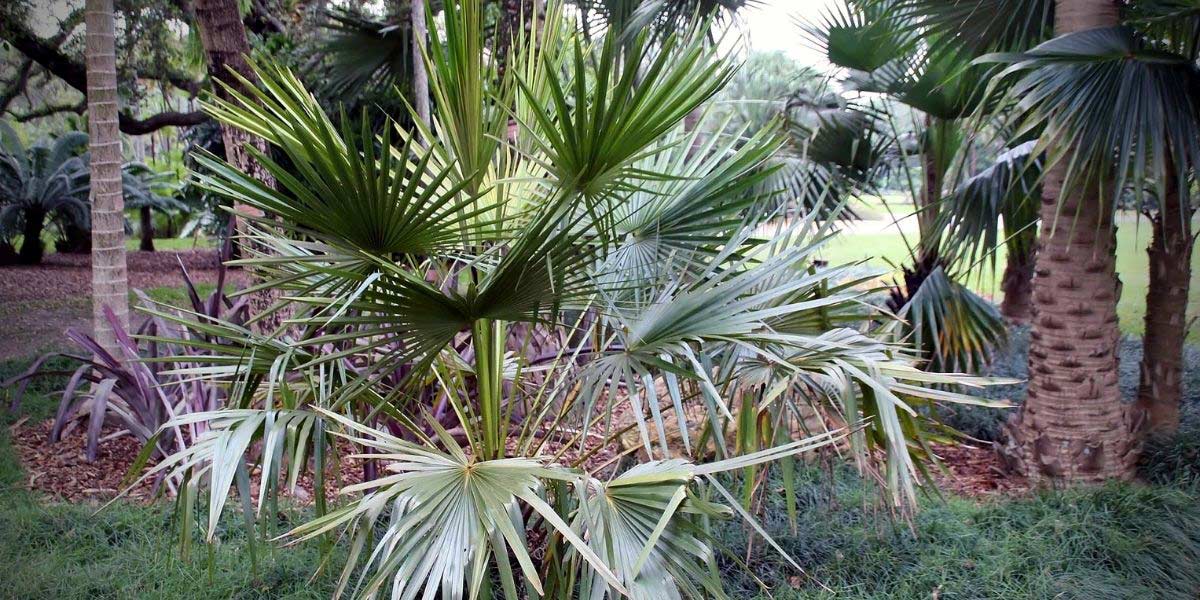
Livistona fulva (photo David J. Stang)
Entretien
If you are growing it in the ground
Regarding the care of Livistona, do not hesitate to water it regularly during the first year, as it enjoys cool, even moist soils. Afterwards, a few waterings during dry periods should suffice.
Unless you live in a region with a mild climate (for example, the Mediterranean basin or the Breton coast), where the risk of frost is low, you will need to protect it in winter. Keep in mind that young plants, recently established in the garden, are naturally more fragile than mature plants that have been in place for several years (this also applies to drought, wind, etc.). Young Livistona chinensis plants, for instance, do not tolerate temperatures below -5 °C, while once mature, they can withstand down to -8 °C.
For more advice, check out our sheet “Palm: how to protect it in winter?”
When you see them, remove the dry leaves by cutting them at the base of the stipe. Livistona gradually renews its foliage: new leaves unfurl at the top of the crown, while the older ones, located lower down, eventually dry out naturally.
Regarding diseases and pests, Livistona can be attacked by the dreadful Paysandisia archon moth, an invasive species from South America that causes significant damage to palms. To learn more, check out our sheet The palm moth, Paysandisia archon: control and treatment
In a pot
If you are growing Livistona in a pot on your terrace, remember to bring it indoors in autumn to protect it from the cold! For example, place it indoors, in a greenhouse, or under a conservatory, in a bright spot, preferably without direct sunlight. Also, avoid sudden changes in temperature and light (you can acclimatise it gradually or choose a location where conditions are least different from its original setting). Similarly, during winter, we recommend reducing watering slightly. In spring, from mid-May or early June, you can take your Livistona back out onto the terrace. Place it in a semi-shaded spot to prevent its foliage from being scorched by the sun. Also, choose a location sheltered from the wind.
In general, if you change its location or growing conditions, acclimatise it gradually. It does not appreciate sudden changes in situation.
When grown indoors, Livistona is sometimes attacked by red spider mites and mealybugs. For red spider mites, feel free to spray water on the foliage, as they dislike humidity. For mealybugs, use a cloth soaked in black soap.
Regarding watering, if your Livistona is in a pot, remember to water regularly, as the substrate dries out faster than in the ground. However, allow the soil to dry out between waterings to prevent the roots from sitting in water constantly, which could lead to rot. Also, do not let water stagnate in the saucer. Reduce watering in winter if the temperature is below 15 °C.
You can also apply liquid fertiliser from spring to autumn, diluting it in the watering water.
Livistona enjoys humid atmospheres: you can mist the foliage or place a saucer with water under the pot, elevating the pot with small stones to prevent it from sitting in water constantly (risk of root rot).
We recommend repotting Livistona every two years, preferably in spring. This will support its growth while renewing the substrate. Choose a slightly larger pot each time.
In years when you do not repot it, you can perform a top dressing: scrape the surface a few centimetres to remove some of the old substrate and add fresh potting soil in its place.
Multiplication
It is possible to propagate Livistona by sowing, but this technique requires time.
Sowing
Sowing Livistona seeds is ideally done at the beginning of spring. To germinate, they primarily need warmth and moisture.
- Soak the seeds in water for 24 hours. This facilitates germination.
- Prepare pots with a special sowing compost, to which you can add perlite. The substrate should be draining and airy. You can also use a mixture of compost and sand.
- Remove the seeds from the water, rinse them, and then sow by placing them in the pots.
- Cover with a layer of substrate and lightly press down.
- Water.
- We recommend placing a lid or a clear plastic bag over the pot to maintain a humid atmosphere.
- Place the pots in a bright location, out of direct sunlight, at a temperature of around 25 °C.
Depending on the species and temperature, the seeds take between one and six months to germinate. The substrate should remain moist until germination. Feel free to water occasionally if necessary, and to open the bag or lift the lid temporarily to aerate.
Association
Make the most of Livistona to create a stunning exotic scene. Feel free to plant it by the edge of a pool or pond to create a refreshing atmosphere reminiscent of holidays. Its large palmate leaves will look splendid alongside other plants with generous and opulent foliage: Japanese bananas (Musa basjoo), Tetrapanax, Fatsia, Colocasia, Castor oil plant, Phormiums, and Cordylines. You can also incorporate other palms, such as Chamaerops humilis, Brahea armata, or Phoenix canariensis. Create a beautiful “jungle” effect by adding some climbing plants, like Akebia quinata or passionflower. Don’t forget the generous foliage of ferns, such as the splendid Blechnum novae-zelandiae! To add colour, take advantage of the stunning flowers of agapanthus, crocosmias, Eucomis, Kniphofias, Cannas, and Bulbines. Discover the unique flowering of Hedychium gardnerianum. Opt for flowers in bright and warm shades: red, orange, yellow… Also enjoy Fargesia bamboos and the grass Hakonechloa macra ‘Nicolas’.
Check out Ingrid’s article on our blog: “10 Exotic and Hardy Plants for a Jungle Garden”
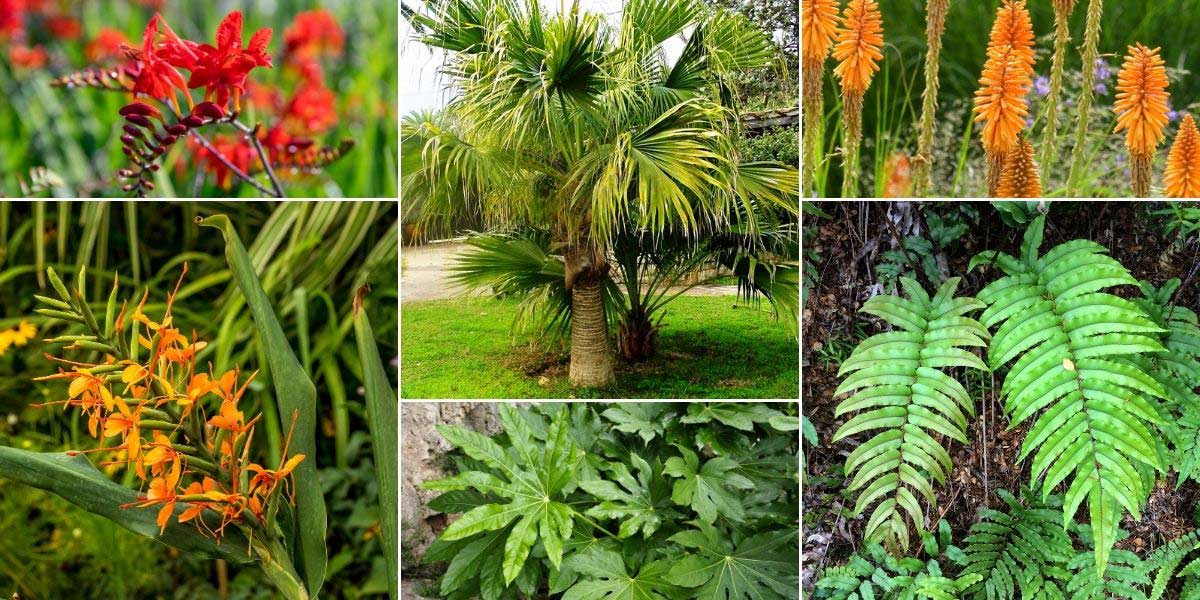
Make the most of Livistona to create a stunning exotic scene! Crocosmia, Livistona chinensis, Kniphofia ‘Fiery Fred’, Hedychium coccineum ‘Tara’ (photo Esin Üstün), Fatsia japonica, and Blechnum novae-zelandiae (photo Muriel Bendel)
You can also incorporate Livistona into a Mediterranean-style garden. In this case, create a mineral environment by setting up a rockery, and plant alongside Livistona lavender, helianthemums, cistus, Phlomis, santolines, and yarrow. Also consider grasses, such as Stipa tenuissima. You can also enjoy the stunning graphics of Yuccas and Agaves!
Useful resources
- Discover our range of Livistona
- For more options, explore our entire range of palms, as well as the associated advice sheets!
- Our sheet “Potted Palm: 7 Remarkable Species for Indoors”
- Subscribe!
- Contents
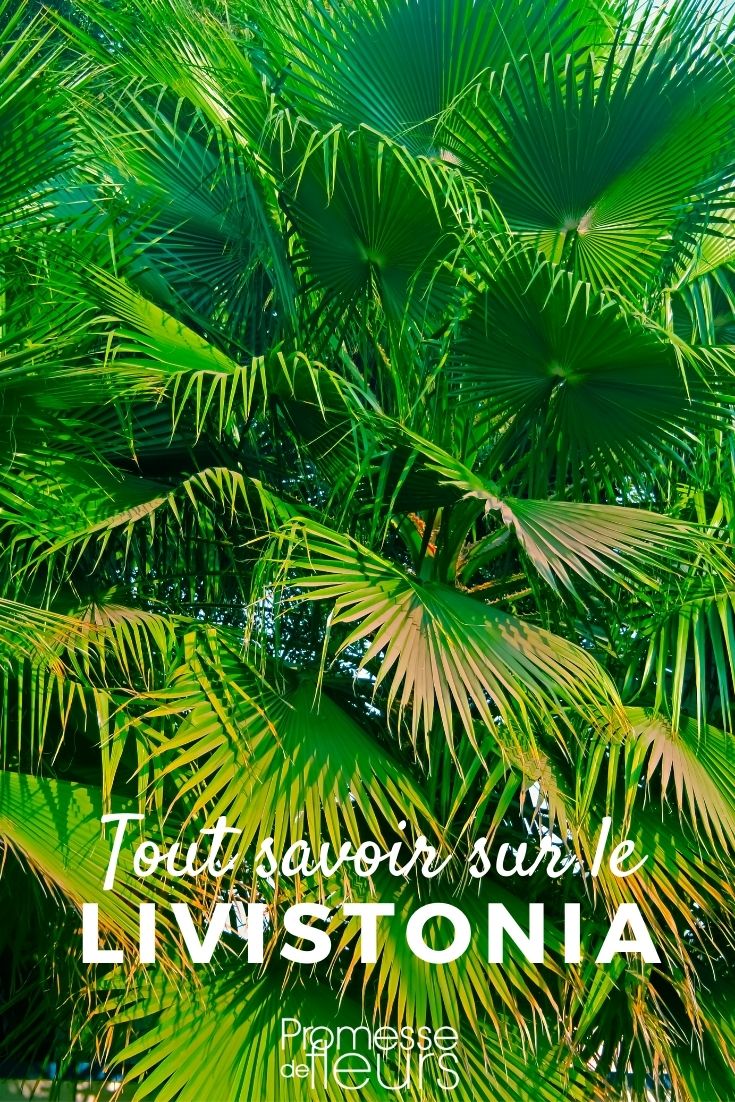



































Comments